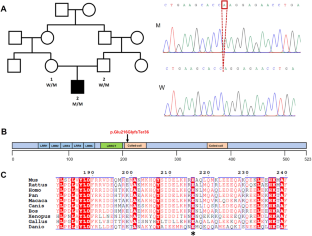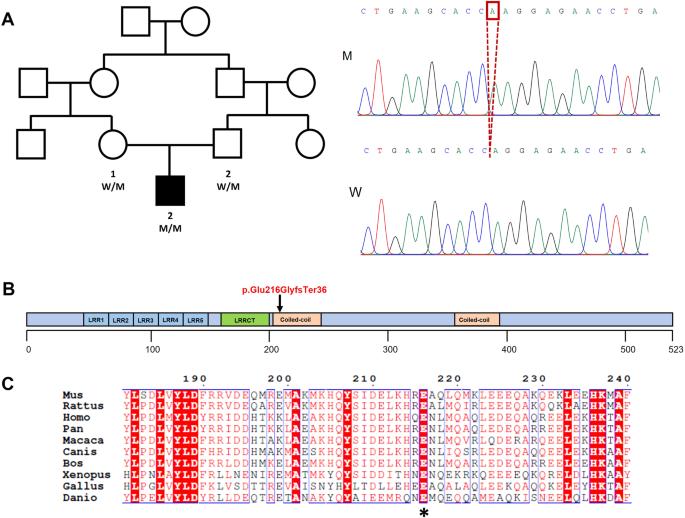Homozygous variant in DRC3 (LRRC48) gene causes asthenozoospermia and male infertility
IF 2.6
3区 生物学
Q2 GENETICS & HEREDITY
引用次数: 0
Abstract
Human infertility affects 10–15% of couples. Asthenozoospermia accounts for 18% of men with infertility and is a common male infertility phenotype. The nexin-dynein regulatory complex (N-DRC) is a large protein complex in the sperm flagellum that connects adjacent doublets of microtubules. Defects in the N-DRC can disrupt cilia/flagellum movement, resulting in primary ciliary dyskinesia and male infertility. Using whole-exome sequencing, we identified a pathological homozygous variant of the dynein regulatory complex subunit 3 (DRC3) gene, which expresses leucine-rich repeat-containing protein 48, a component of the N-DRC, in a patient with asthenozoospermia. The variant ENST00000313838.12: c.644dup (p. Glu216GlyfsTer36) causes premature translational arrest of DRC3, resulting in a dysfunctional DRC3 protein. The patient’s semen count, color, and pH were normal according to the reference values of the World Health Organization guidelines; however, sperm motility and progressive motility were reduced. DRC3 protein was not detected in the patient’s sperm and the ultrastructure of the patient’s sperm flagella was destroyed. More importantly, the DRC3 variant reduced its interaction with other components of the N-DRC, including dynein regulatory complex subunits 1, 2, 4, 5, 7, and 8. Our data not only revealed the essential biological functions of DRC3 in sperm flagellum movement and structure but also provided a new basis for the clinical genetic diagnosis of male infertility.


DRC3(LRRC48)基因的同卵变异导致无精子症和男性不育。
人类不育症影响着 10-15% 的夫妇。无精症占男性不育症的 18%,是一种常见的男性不育症表型。nexin-dynein调节复合物(N-DRC)是精子鞭毛中的一种大型蛋白质复合物,它将相邻的双微管连接起来。N-DRC缺陷会破坏纤毛/鞭毛运动,导致原发性纤毛运动障碍和男性不育。通过全外显子组测序,我们在一名患有无精子症的患者体内鉴定出了表达富亮氨酸重复含蛋白 48(N-DRC 的一个组成成分)的肌球蛋白调节复合体亚基 3(DRC3)基因的病理同源变体。变异ENST00000313838.12:c.644dup (p. Glu216GlyfsTer36)导致DRC3过早转译停滞,导致DRC3蛋白功能失调。根据世界卫生组织指南的参考值,患者的精液数量、颜色和 pH 值均正常,但精子活力和进行性运动能力下降。患者精子中未检测到 DRC3 蛋白,精子鞭毛的超微结构被破坏。更重要的是,DRC3变体减少了与N-DRC其他成分的相互作用,包括动力蛋白调节复合体亚基1、2、4、5、7和8。我们的数据不仅揭示了DRC3在精子鞭毛运动和结构中的重要生物学功能,还为男性不育症的临床基因诊断提供了新的依据。
本文章由计算机程序翻译,如有差异,请以英文原文为准。
求助全文
约1分钟内获得全文
求助全文
来源期刊

Journal of Human Genetics
生物-遗传学
CiteScore
7.20
自引率
0.00%
发文量
101
审稿时长
4-8 weeks
期刊介绍:
The Journal of Human Genetics is an international journal publishing articles on human genetics, including medical genetics and human genome analysis. It covers all aspects of human genetics, including molecular genetics, clinical genetics, behavioral genetics, immunogenetics, pharmacogenomics, population genetics, functional genomics, epigenetics, genetic counseling and gene therapy.
Articles on the following areas are especially welcome: genetic factors of monogenic and complex disorders, genome-wide association studies, genetic epidemiology, cancer genetics, personal genomics, genotype-phenotype relationships and genome diversity.
 求助内容:
求助内容: 应助结果提醒方式:
应助结果提醒方式:


